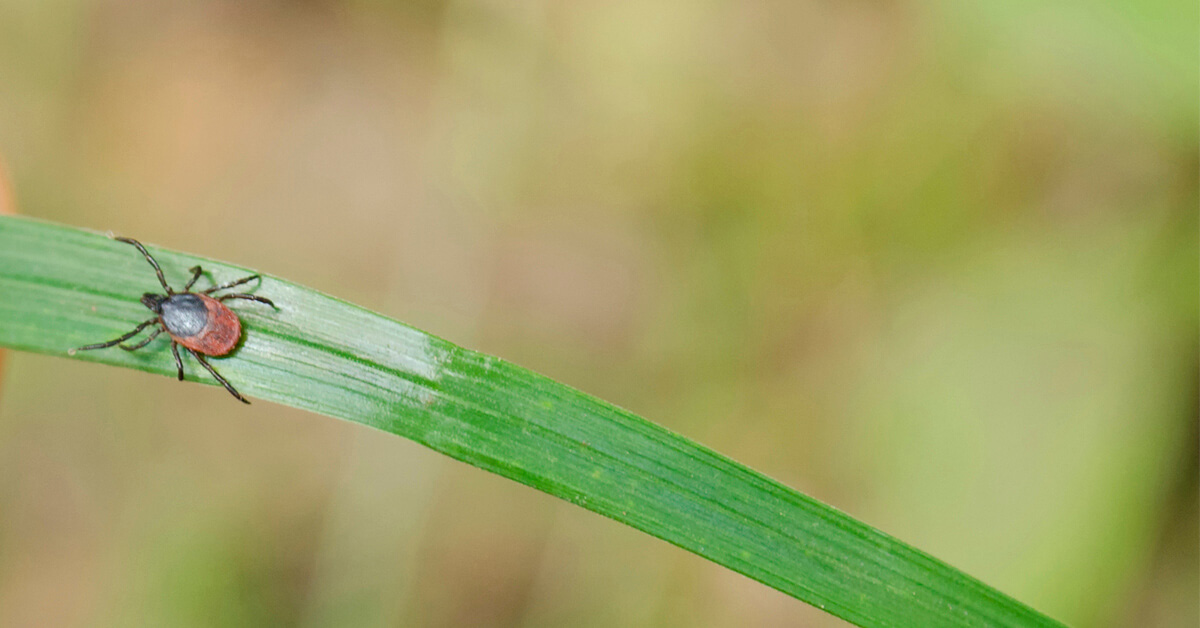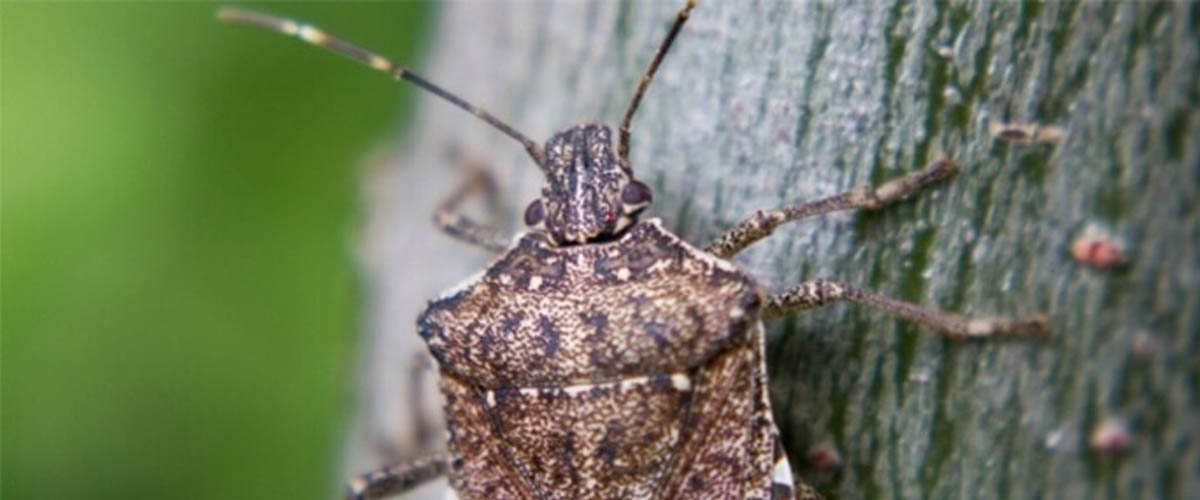How to Identify and Kill Spotted Lanternflies
Invasive pest experts consider spotted lanternflies one of the most serious insect threats to ever hit the United States. Since their 2014 detection in Pennsylvania, these native Southeast Asian pests have increased their range, damaging ornamental plants and agricultural crops in their way.
The first five years saw spotted lanternflies stay near Pennsylvania. But by the end of the second five years, spotted lanternflies were found in 18 states, from New York to Georgia and west to Illinois. In addition, the West Coast has had numerous cases of spotted lanternflies intercepted on trucks and shipments from the Northeast.
If you live in the U.S., your region is at risk for potential infestations of these devastating insects. By learning how to identify and control spotted lanternflies, you can take a stand and help protect against their spread.
- Identifying Spotted Lanternfly Life Stages
- Detecting Spotted Lanternfly Damage
- Killing and Preventing Spotted Lanternflies
Identifying Spotted Lanternfly Life Stages
Despite the moth-like look of spotted lanternfly adults, these damaging planthopper pests are true bugs. Their offspring hatch as nymphs, not larvae. Their distinctive appearance makes it easy to identify these invaders at every life stage.
Spotted lanternflies overwinter as eggs, which hatch into baby spotted lanternflies in spring. The nymphs grow and molt through four stages, called instars, and get more destructive as they mature.
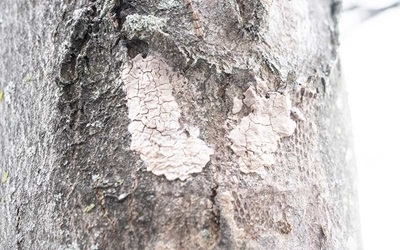
Spotted lanternfly egg masses look like lichens or dried mud.
Spotted lanternfly eggs make their appearance in fall as mated adults lay masses of eggs. Found on nearly any hard surface — from patio furniture and car grills to tree trunks — the waxy, one-inch egg masses look like putty when they're fresh. Once they dry, they look like cracked mud. Each mass contains up to 60 eggs, laid in unusual vertical columns.1
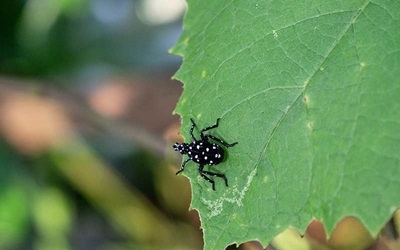
Young, black-stage spotted lanternfly nymphs have a polka-dot appearance.
Black-stage nymphs make up the first three instars, from spring hatching through midsummer's third molt. Early-stage spotted lanternfly nymphs grow up to 1/4 inch long. Bright white spots dot their wingless black bodies and legs.
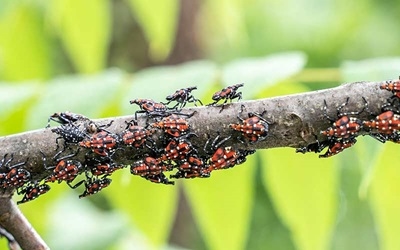
Red-stage nymphs can pierce bark and damage trees.
Red-stage nymphs are the spotted lanternfly's final, most damaging instar. Active from midsummer through autumn, these juvenile spotted lanternflies grow up to 3/4 inch long before maturing into adults. Bright red color develops on their white-spotted black bodies.

When disturbed, adults spread their wings to show patches of red.
On trees and other plants, adult spotted lanternflies are usually seen with their wings folded like tents above their backs. With folded wings, these pests measure about 1 inch long and 1/2 inch wide.
Spotted lanternfly adults start appearing in midsummer and keep feeding and damaging plants until a killing frost in fall. Their pinkish forewings — spotted with black — have a brick-like pattern toward their tips. The black-and-white hindwings have bright red patches with black spots. When extended, the colorful wings span 2 inches.
Detecting Spotted Lanternfly Damage
Spotted lanternflies damage plants and property at all stages of their destructive lives. These pests have mouthparts that pierce plant tissue and suck vital juices from their target plants.
Black-stage nymphs can't penetrate woody plants and tree bark. So these immature spotted lanternflies focus on damaging annuals, perennials and tender, new plant growth instead. Red-stage nymphs and adult spotted lanternflies can pierce woody bark; these final stages typically attack trees.
The Tree of Heaven, known by the scientific name Ailanthus altissima, is the spotted lanternfly's preferred host plant. Found throughout the United States, this invasive Asian tree directly supports the pest's spread in the U.S. and abroad. But spotted lanternflies have adapted quickly.
The spotted lanternfly's U.S. diet encompasses more than 100 plant species, including grapevines, fruit trees from apples to peaches, blueberries, maple trees, walnut trees, birch and pine.2 As the pest moves into new areas with different plants and crops, experts expect that number to grow.
Spotted lanternflies are swarm feeders that gather in large groups to feed in early evening. Unmistakable mobs of thousands of adults may converge on a single tree trunk, consuming significant amounts of tree sap.
Damaged trees continue to weep sap after the attack. Weakened trees and plants fail to thrive, don't produce fruit or even die. In some areas, infestations have devastated vineyards, agricultural crops and ornamental plants.
Large quantities of honeydew — a polite word for spotted lanternfly excrement — is an unpleasant byproduct of spotted lanternfly infestations. The sticky substance accumulates, along with oozing sap, around the bases of trees where the pests feed.
Excreted honeydew also blankets sidewalks, patios, furniture, cars and any other objects nearby. The pooling honeydew attracts wasps, ants and other pests, then develops a whitish fungus that ripens into black sooty mold.
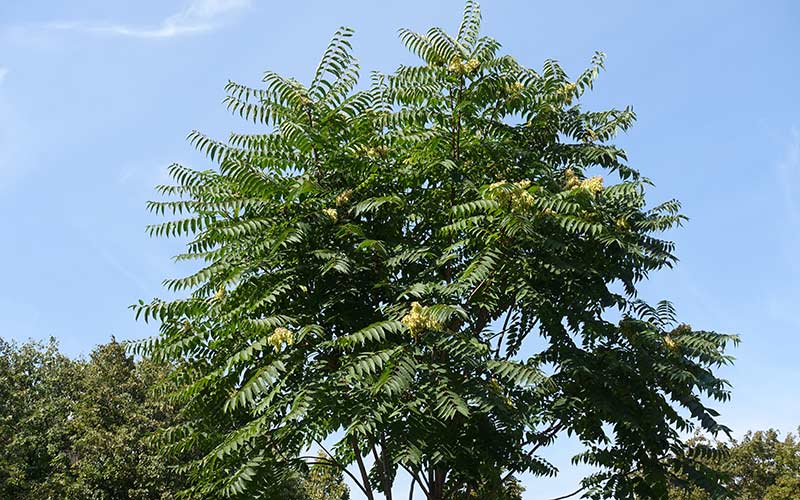
The invasive Tree of Heaven attracts masses of spotted lanternflies.
Killing and Preventing Spotted Lanternflies
Because spotted lanternflies aren't native to North America, the natural predators here don't do much to keep these pests in check. Taking steps to kill, control and prevent these invasive pests is critical to protect your property and help stop the spotted lanternfly's spread.
If you have Tree of Heaven on your property, consider it a spotted lanternfly magnet. You may want to remove this invasive plant before it draws spotted lanternflies to your home.
Effective control of spotted lanternfly nymphs and adults targets these pests at all life stages. Inspect your property thoroughly for egg masses in fall and winter. Scrape the masses from their surfaces and destroy the eggs to prevent spotted lanternfly nymphs in spring.
If you have known infestations in your area — or you expect spotted lanternflies will arrive soon — be proactive with preventative treatments to protect against these pests.
Treat landscape plants, shrubs and trees with Amdro Quick Kill Insect Killer for Lawn & Landscape Ready To Spray or Amdro Quick Kill Insect Killer for Lawn & Landscape Concentrate to control spotted lanternfly nymphs and adults.
These two highly effective residual Amdro insecticides work in minutes to kill existing spotted lanternflies by contact. Then they keep protecting treated plants and trees against new spotted lanternflies for up to three months. You can even treat your home's foundation up to a height of 3 feet.
When treating your property for spotted lanternflies, give extra attention to tree trunks where these pests gather. Though early black-stage nymphs don't pierce tree bark, they often move up and down tree trunks near the ground. They're strong jumpers, too.
Late red-stage nymphs and adults gather in those same areas, so targeted treatment equals maximum results. From the time they mature, adults feed for about one month in late summer and fall. Then they lay eggs. Treat them during this crucial time to prevent egg masses and future generations.
If you see spotted lanternflies in a new area, take a picture so experts can confirm the pest and life stage. Then kill the pest so it can't reproduce, and report the sighting to your local county extension office or your state Department of Agriculture.
With the help of Amdro brand, you can protect your plants against spotted lanternfly damage, reclaim your property and help stop the spread of these destructive pests.
Always read product labels thoroughly and follow the instructions carefully.
Sources:
1. B. Eshenauer, "Spotted Lanternfly IPM," New York State Integrated Pest Management, Cornell University.
2. T. Simisky, "Spotted Lanternfly," University of Massachusetts Amherst.


